); and it is as much as customers to examine whether or not the dual-layer OLED miracle resides as much as its guarantees.
Moreover, this know-how is claimed to supply brighter visuals and improved energy effectivity.
Single-layer OLED (Natural Gentle-Emitting Diode) screens are constructed with a single layer of natural compounds that emit gentle when {an electrical} present is utilized. This know-how permits for a variety of colours and deep blacks as a result of every pixel might be managed independently, turning on and off as wanted, eliminating the necessity for a backlight.
That is the way you get wonderful excessive distinction ratios and true blacks, as unlit pixels don’t emit any gentle. Single-layer OLED shows are recognized for his or her thinness, flexibility, and effectivity; no surprise they’re so well-liked. They provide wonderful viewing angles and response instances, contributing to smoother animations and fewer movement blur in dynamic pictures.
After all, single-layer OLED shows have their limitations and downsides. They’re vulnerable to degradation over time, resulting in points like burn-in, the place static pictures “burn” into the show, leaving a ghostly residue. Creepy stuff!
Moreover, whereas they excel in distinction and colour accuracy, they could wrestle with peak brightness in comparison with LED screens or double-layer OLEDs. The lifetime of those shows, notably the blue natural compounds, is shorter than that of different applied sciences, which may have an effect on the general longevity of the display screen.
Double-layer OLED display screen know-how defined


Double-layer OLED know-how builds upon the single-layer method by introducing an extra layer of natural light-emitting compounds. This setup goals to reinforce the show’s brightness, effectivity, and sturdiness. By having two layers, the display screen can distribute the workload, doubtlessly growing the general lifespan of the show and decreasing the probability of burn-in.
The extra layer permits for extra gentle to be emitted with out considerably growing energy consumption, resulting in brighter shows which are nonetheless energy-efficient.
However – that is even higher – double-layer OLEDs can enhance colour accuracy and quantity by offering a broader vary of colours and deeper colour saturation. This know-how retains the advantages of single-layer OLED, resembling excessive distinction ratios and adaptability, whereas making an attempt to deal with a few of its limitations. The inclusion of a second layer can, nonetheless, end in a barely thicker show, which is likely to be a consideration in ultra-thin gadget designs.
So, how do you want your telephone shows? Skinny (and with a burn-in proclivity) or thick (with juicy, wealthy colours and an prolonged lifespan)?
One of many important benefits of double-layer OLED screens is their improved longevity and resistance to burn-in, making them extra appropriate for gadgets with static pictures or interfaces. Moreover, the improved brightness ranges make these screens extra readable in direct daylight or brightly lit environments.
Execs:
- Elevated brightness and effectivity
- Improved longevity and resistance to burn-in
- Enhanced colour accuracy and quantity
- Retains excessive distinction ratios and adaptability
Cons:
- Barely thicker than single-layer OLED screens
- Probably larger manufacturing prices
In essence, double-layer OLEDs intention to reinforce brightness, colour, and sturdiness whereas sustaining some great benefits of OLED know-how, albeit on the potential value of elevated thickness and manufacturing complexity.
Single-layer vs. Double-layer OLED (for foldables)
Right here’s a query that telephone makers might be asking themselves in 2025, and onwards: “Ought to we go single or twin for our subsequent folding gadget?”Single-layer OLED screens, being thinner and extra versatile, are naturally suited to the bending and flexing required in foldable telephones. Their flexibility facilitates the creation of gadgets that may be folded with out damaging the show.
Double-layer OLEDs, whereas providing improved brightness and sturdiness, current a problem as a consequence of their barely elevated thickness. In foldable telephone functions, the place each millimeter contributes to the gadget’s general bulk and foldability, this is usually a main subject.
Apple is taking notes, as ordinary
There’s a model that may even soar on the dual-layer OLED wagon: Apple. It’s simply that Cupertino wants a number of extra years to kind issues out.
“In 2028, we count on the iPad Air to go OLED as properly, with the iPad Air utilizing single-stack and the iPad Professional utilizing two-stack tandem OLEDs,” stated Omdia researcher Kang Min-soo not too long ago.
Nicely, we hope by 2028 the iPhone will get the dual-layer OLED therapy as properly. If by that point Apple’s telephone bends in two, nonetheless, it’s going to in all probability stay with a single-layer OLED show. Not that there’s one thing mistaken with it…
It’s fascinating to see the place Samsung will take its followers in 2025 by way of show know-how. Once more, the display screen on the Galaxy S24 Extremely has confirmed to be stable (in each facet, not simply in mere toughness):


Do you care about dual-layer OLEDs?
Each the Magic 6 Final (~$1000) and the Magic 6 RSR (~$1400) aren’t low cost. Perhaps BOE’s new dual-layer OLED show is guilty for that?
I don’t count on a two-stack tandem OLED in, say, the Pixel 8a, however it will likely be good to see this show know-how unfold throughout extra gadgets. Yup, it’s going to include a worth, however, eh, every little thing is pricey as of late. Even eggs.


